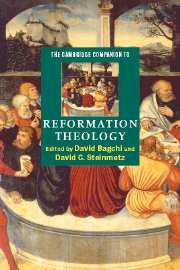Book contents
- Frontmatter
- Introduction
- 1 Late medieval theology
- 2 Lollardy
- 3 Hussite theology and the law of God
- 4 The theology of Erasmus
- 5 Luther
- 6 Melanchthon
- 7 Confessional Lutheran theology
- 8 The theology of Zwingli
- 9 Bucer
- 10 The theology of John Calvin
- 11 John Calvin and later Calvinism
- 12 The theology of Thomas Cranmer
- 13 The theology of the English reformers
- 14 The Scottish Reformation
- 15 An introduction to Anabaptist theology
- 16 Catholic theologians of the Reformation period before Trent
- 17 The Council of Trent
- Conclusion
- Select bibliography
- Index
- Series list
Conclusion
directions of future research
Published online by Cambridge University Press: 28 May 2006
- Frontmatter
- Introduction
- 1 Late medieval theology
- 2 Lollardy
- 3 Hussite theology and the law of God
- 4 The theology of Erasmus
- 5 Luther
- 6 Melanchthon
- 7 Confessional Lutheran theology
- 8 The theology of Zwingli
- 9 Bucer
- 10 The theology of John Calvin
- 11 John Calvin and later Calvinism
- 12 The theology of Thomas Cranmer
- 13 The theology of the English reformers
- 14 The Scottish Reformation
- 15 An introduction to Anabaptist theology
- 16 Catholic theologians of the Reformation period before Trent
- 17 The Council of Trent
- Conclusion
- Select bibliography
- Index
- Series list
Summary
What next?
Or, to frame the question somewhat more precisely, what problems in historical theology are likely to engage students of the Reformation in the twenty-first century? The short answer, of course, is that historians will continue to be fascinated by many of the same problems that fascinated their predecessors in the twentieth. There will always be fresh generations of scholars who will be captivated by the theology of the great figures of the sixteenth century - whether Luther or Calvin or Teresa of Avila - and who will devote their careers to resolving unresolved issues in the interpretation of their thought.
Popes were often reluctant to take the risks inherent in the convocation of a general council. They were painfully aware that the Council of Constance had deposed three competing popes and installed a fourth. By the time of Luther, however, it was generally conceded, even by theologians who were jealous defenders of papal power, that under certain circumstances the convocation of a general council might be the church’s only recourse to resolve a crisis that had proved impossible to resolve in any other way.
- Type
- Chapter
- Information
- The Cambridge Companion to Reformation Theology , pp. 248 - 256Publisher: Cambridge University PressPrint publication year: 2004
- 3
- Cited by



